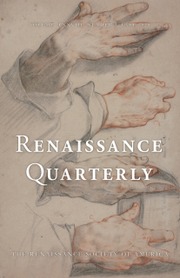Article contents
Painting and Poetry in Early Modern Spain: The Primacy of Venetian Colore in Góngora’s Polyphemus and The Solitudes*
Published online by Cambridge University Press: 20 November 2018
Abstract
Luis de Góngora’s Fable of Polyphemus and Galatea (1612) and The Solitudes (1613) have inspired comparisons to painting ever since they first appeared in manuscript form at the Court of Philip III. Engaging the doctrine of ut pictura poesis, which notes the kinship between painting and poetry, Góngora creates pictorial conceits modeled in color as if using a painter’s palette, and thus his poems read like imaginary art galleries. By way of both plastic and discursive references to the Venetian school, Góngora inserts his poetry into one of the most salient polemics of his time, the paragone tra colore e disegno, the debate over the supremacy of Venetian color versus Florentine draftsmanship. This essay seeks to provide a reading of Góngora’s major poems in light of the paragone as it played out in seventeenth-century Spain among art theorists and painters such as Francisco Pacheco and Domenico Theotocopoulis (El Greco), and intertwined with related discourses pertaining to artistic progress and innovation, including the link between aesthetics and religious reform.
- Type
- Research Article
- Information
- Copyright
- Copyright © Renaissance Society of America 2013
Footnotes
This article is dedicated to the memory of Professor Isaías Lerner, who generously bequeathed to his students the foundations of rigorous scholarship. Nascent versions of the ideas presented herein first appeared in my doctoral dissertation, Painting in the Poetry of Luis de Góngora (CUNY Graduate Center, 2009). I am immensely grateful to my thesis advisor, Professor Lía Schwartz, and members of my committee, including Professor Lerner and Professor Ottavio DiCamillo, for their astute guidance and unfailing support. I also thank the two anonymous reviewers for RQ for helping to improve this article by way of their insightful comments.
References
- 1
- Cited by




